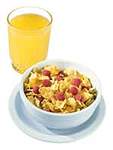April 2000 - Well-nourished children go to school ready to learn. They have the energy, stamina and self-esteem that enhance their ability to do well. Healthy eating along with regular physical activity will help keep both mind and body fit.
Research shows that children who eat breakfast regularly do better in school.
 |
Breakfast
eaters generally:
|
Breakfast skippers may:
- tend to be less attentive;
- suffer emotional instability or irritability;
- have a decreased ability to recall and apply new information;
- have low energy levels;
- have unfavorable behavior; and
- have poor performance.
A Morning Routine
Having a calm breakfast ritual in the morning is very helpful. Children are
more likely to eat breakfast if someone will sit down with them. Today, with
busy schedules and working parents, this element is often replaced with a
quick donut in the car on the way to school.
Breakfast should include food from all four food groups: meat, dairy, grain, fruits/vegetables. Even if children have to prepare their own breakfast in the mornings, the American Dietetic Association recommends having easy-to-prepare foods available for them from the four food groups including fruit juices and milk.
Most children can handle making easy breakfast foods like these:
- Cheese slices melted on toast
- Iron-fortified cereal with banana slices
- Peanut butter spread on a whole grain waffle or bagel
- Fruit and milk on instant oatmeal
- Cold pizza
- Leftover spaghetti or macaroni and cheese
- Apple and cheese slices between whole wheat or graham crackers
- Breakfast cereal topped with fresh fruit and a scoop of frozen yogurt
Nutrition
Parents should watch the nutritional value their children are getting each
morning.
Don't let them go overboard on the sugar. Look for cereals with no more than five grams of sugar per serving.
Keep an eye on fiber. A bowl of whole-grain cereal, like Wheaties, bran flakes or Cheerios, will keep children fuller longer than sugarcoated brands because of their high fiber content. Whole-grain cereals, bagels and wheat-batter pancakes (which can be made in advance and frozen, then simply thrown into the microwave to thaw) are all good sources of fiber.
There is a place for eggs. When cooked thoroughly and used in moderation, eggs can be an important protein source for children.
Children often aren't hungry until after they have been mobile for several hours. If this sounds like your child, have a snack your child can eat in the car on the way to school. Milk, juice, yogurt and cereal all come in small cartons or boxes and are easily portable. Toast, English muffins, bagels and a piece of fresh fruit also work well. Try spreading peanut butter on a piece of whole wheat bread and wrapping it around a banana.
Eating out? Most fast-food restaurant chains offer a few healthier food items for breakfast. Choose pancakes, bran muffins, Wheaties, Cheerios and orange juice or low-fat milk.